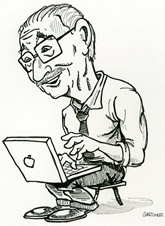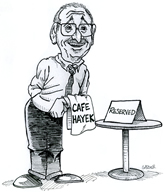Adam Michel’s and Veronique de Rugy’s letter in today’s Wall Street Journal is excellent:
Paul Ryan and Kyle Pomerleau propose a destination-based cash-flow tax as “A Tax-Reform Alternative to Trump’s Tariffs” (op-ed, Oct. 15). But their argument mistakes a novel blackboard theory for sound policy. A DBCFT would grant Washington a new money spigot while leaving protectionism intact.
President Trump believes tariffs are fundamentally good. If the Supreme Court reins in his use of the International Emergency Economic Powers Act, he will turn to other authorities such as Section 301. If Congress grants him the power to impose a new border-adjusted tax, we will get both.
The notion that a DBCFT would address Mr. Trump’s trade concerns by being a smarter way to tax imports and that currency appreciation will offset its effects are mutually exclusive. If the dollar appreciates enough to neutralize the tax, the market will adjust and trade flows and the real trade deficit won’t change much. If it doesn’t, the DBCFT will raise prices, invite retaliation and disrupt supply chains.
The policy’s supposed fiscal virtue is precisely what makes it dangerous. The tax is popular in Washington because it’s a money machine. We should remember why Congress abandoned the policy in 2017. The DBCFT is a clever acronym for an old Beltway habit: spend more, tax more and call it reform. The solution to Mr. Trump’s tariffs is more mundane: Congress must reassert its power to levy tariffs and limit spending.
Adam Michel and Veronique de Rugy
Cato Institute and Mercatus Center
Year-over-year inflation is indeed at about 3 percent, which is markedly lower than it was during the Biden administration. But notice that the inflation rate is ticking upward, not downward, and that this still remains well above the Fed’s 2 percent target and is drifting further away from it. Still, trotting out “inflation” is odd. Economists have been very clear that tariffs don’t cause inflation the same way that printing money, which consistently pushes prices higher month after month, does. Instead, tariffs cause what’s known as a “level effect” in that they work like a sales tax that gets added to the price tag once and stays there until it is changed. The washing machine that used to cost $500, for example, now costs $625 thanks to a 25 percent tariff.
…..
Looking at more granular data than the BLS does reveals a more detailed picture, and one that comports with the lived experiences of everyday Americans. Harvard’s Pricing Lab analyzed 350,000 different products. Their findings are stunning. Not only are imported goods getting more expensive, but so are domestically produced goods. Coffee prices, for example, are up almost 9 percent relative to their pre-tariff trend. Furniture, almost 6 percent, and that’s before the new 25 percent tariff on furniture takes effect.
…..
Lynn would have us believe that tariffs are being paid almost entirely by foreign countries. He writes, “the extra $30 billion a month in revenue the tariffs are already generating is not exactly ‘free money.’ But it’s as close to it as anything we have seen for a long time.” The problem with his analysis is that this claim was not true during the first Trump administration, and it’s not true during the second, either.
Tariff revenues come straight from the American people. In Cleveland, 87 percent of manufacturing firms report that their costs have increased because of tariffs and the surrounding uncertainty of their implementation. Looking at import shares and tariff pass-throughs, for firms that receive at least half of their materials from imports, 25 percent report that they will pass all the tariff along, 50 percent report that they will pass at least a majority along, and only 25 percent report that they plan to pass only “some” of the cost increases along to customers. None reported that they will not pass at least some of the cost along to consumers.
Reason‘s Jack Nicastro eloquently exposes the weaknesses in Chad Squitieri’s argument that Trump’s “Liberation Day” tariffs are constitutional. Here’s Nicastro’s well-grounded conclusion:
By Squitieri’s argument, so long as the president continues re-upping an imagined national emergency, he may impose whatever tariff rates he wants, on whichever countries he wants, for however long he wants. The Constitution, 250 years of jurisprudence, and common sense all say otherwise.
Ted Nordhaus explains why he no longer believes that climate change is an existential threat to humanity. Three slices:
This is all the more confounding given that the good news extends well beyond projections of long-term warming. Despite close to 1.5 degrees of warming over the last century, global mortality from climate and weather extremes has fallen by more than 96 percent on a per-capita basis. The world is on track this year for what is almost certainly the lowest level of climate-related mortality in recorded human history. Yes, the economic costs of climate extremes continue to rise, but this is almost entirely due to affluence, population growth, and the migration of global populations toward climate hazards: mainly cities in coastal regions and floodplains.
…..
In the late 2000s, the climate advocacy community figured out that framing climate change as a future risk would not prove politically sufficient to transform the U.S. and global energy systems in the way that most believed necessary. And so the movement set about attempting to move the locus of climate catastrophe from the future to the present, framing extreme weather events not only as harbingers for future catastrophes, but as fueled by current climate change.
But this narrative conflicts with existing evidence, including data collected by political scientist and former environmental studies professor Roger Pielke Jr. His work, going back to the mid-1990s, showed again and again that the normalized economic costs of climate-related disasters, when adjusted for wealth and economic growth, weren’t increasing, despite the documented warming of the climate.
The reason for my shift in opinion wasn’t only that Pielke had produced strong evidence that undermined a key claim of the climate advocacy community. It wasn’t even witnessing Pielke’s cancellation, which was brutal. It was, rather, that I came to understand why you couldn’t find a climate change signal in the disaster loss data, despite close to 1.5 degrees of warming over the last century.
…..
The first reason is that highly educated people with high levels of science literacy are no less likely to get basic scientific issues wrong than anyone else when the facts conflict with their social identities and ideological commitments. Yale Law professor Dan Kahan has shown that people who are highly concerned about climate change actually have less accurate views about climate change overall than climate skeptics, and that this remains true even among partisans with high levels of education and general science literacy. Elsewhere, Kahan and others have demonstrated that on many issues, highly educated people are often more likely to hold stubbornly onto erroneous beliefs because they are adept at rationalizing their ideological commitments.
The second reason is that there are strong incentives to overestimate climate risk if you make a living doing left-of-center climate and energy policy. The capture of Democratic and progressive politics by environmentalism over the last generation has been close to total. Meanwhile, the climate movement has effectively conflated consensus science about the reality and anthropogenic origins of climate change with catastrophist claims about climate risk, for which there is no consensus whatsoever.
“Artificial intelligence needs electricity, and electricity needs freedom.”
And Scott Lincicome shares this other happy fact.
Vile.



